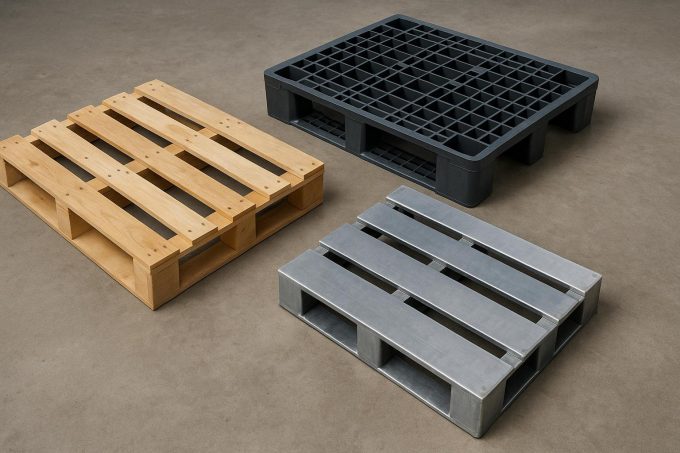Understanding Different Types of Pallets
Pallets play a pivotal role in the logistics and supply chain industry, acting as foundational units for the transportation and storage of goods. Their application transcends across industries that include manufacturing, retail, pharmaceuticals, and more. Pallets primarily come in three core material types: wooden, plastic, and metal. Each presents unique characteristics that influence their efficiency, cost, and application potential within different industrial contexts.
Wooden Pallets
Wooden pallets have been a mainstay in logistics due to their cost-effectiveness and versatility. Made predominantly from hardwood or softwood, these pallets offer a substantial structural framework capable of supporting heavy loads, thereby being suitable for numerous industries. Nevertheless, they pose challenges related to environmental conditions like moisture exposure and potential pest infestation. Such drawbacks necessitate treatments such as heat treatment or fumigation to ensure their viability, especially for global shipping. The ability to customize and recycle wooden pallets adds to their appeal, making them an enduring choice for businesses seeking practical solutions.
Pros of Wooden Pallets
Wooden pallets are particularly favored for their affordability. Being readily available, they present a competitive cost advantage, especially for businesses with budget constraints. Moreover, they are easily repairable compared to their plastic or metal counterparts, allowing for extended utility with minimal financial outlay. Biodegradability further aligns them with environmentally conscious disposal practices, reducing their ecological footprint.
Cons of Wooden Pallets
Despite the benefits, wooden pallets are not without their challenges. A notable concern is their vulnerability to contamination from bacteria and fungi, particularly if the pallets become wet. This susceptibility requires diligent management and often necessitates additional treatment processes to comply with international shipping standards, especially regarding pest control.
Plastic Pallets
Plastic pallets are recognized for their durability and resistance to varying environmental conditions. Constructed from materials like polyethylene or polypropylene, these pallets are lightweight yet robust, suitable for scenarios necessitating tight hygiene control such as in pharmaceutical or food industries. Their ability to withstand chemical exposure, insects, and harsh weather elements makes them an ideal choice where stringent sanitary conditions are prioritized.
Pros of Plastic Pallets
One of the main advantages of plastic pallets is their longevity, which often surpasses that of traditional wooden versions. Unlike wooden pallets, their non-porous surface effectively prevents moisture absorption, providing exponential benefits in maintaining hygiene. Furthermore, many plastic pallet designs incorporate recyclability, which bolsters their environmental credentials over time, creating a sustainable cycle of use and reuse.
Cons of Plastic Pallets
However, the initial investment in plastic pallets is higher than that for wooden ones, which can potentially deter some businesses from opting for them. Over time and with exposure to extreme temperatures, plastic pallets can become brittle. Conversely, repairing plastic pallets is not as straightforward or economical as fixing wooden ones, which is a consideration for businesses pondering long-term value.
Metal Pallets
Metal pallets, typically manufactured from durable materials like stainless steel, aluminum, or iron, provide exceptional strength and support. These are especially beneficial in situations where extreme conditions are typical, including high-temperature environments or when heavy loads are a constant factor. The robust architecture of metal pallets ensures reliability and performance, making them uniquely suitable for specialized applications in demanding industries.
Pros of Metal Pallets
The resilience of metal pallets is unmatched; they stand as the most durable option among the types discussed. Apart from being fireproof, they also display an extensive lifespan, signifying an ideal cost-effective solution for scenarios where durability outweighs initial expenditure considerations. Their resistance to moisture and pest damage further enhances their suitability for intense operational demands.
Cons of Metal Pallets
The primary downside of metal pallets is their cost, positioning them as a premium choice limited to specific industrial applications. Their weight adds another layer of consideration, complicating manual handling and potentially leading to escalated transportation costs. This weight factor not only affects logistics routes but also influences handling technology and labor requirements.
Conclusion
Choosing the appropriate type of pallet for your operations involves a careful evaluation of the distinct benefits and challenges each material presents. The selection process should account for factors such as cost, durability, environmental considerations, and hygiene requirements. Wooden pallets stand out for their affordability and reparability, appealing to budget-conscious and eco-friendly operations. Plastic pallets, with their superior hygienic properties and resilience, cater to industries where sanitation cannot be compromised. Meanwhile, metal pallets, although costly, provide unparalleled strength and longevity necessary for high-stress environments. Each type finds its niche, and the decision ultimately hinges on specific logistical demands and strategic business priorities. For further insights into selecting the optimal pallet for your needs, consultations with logistics experts and material handling specialists can provide targeted guidance.

